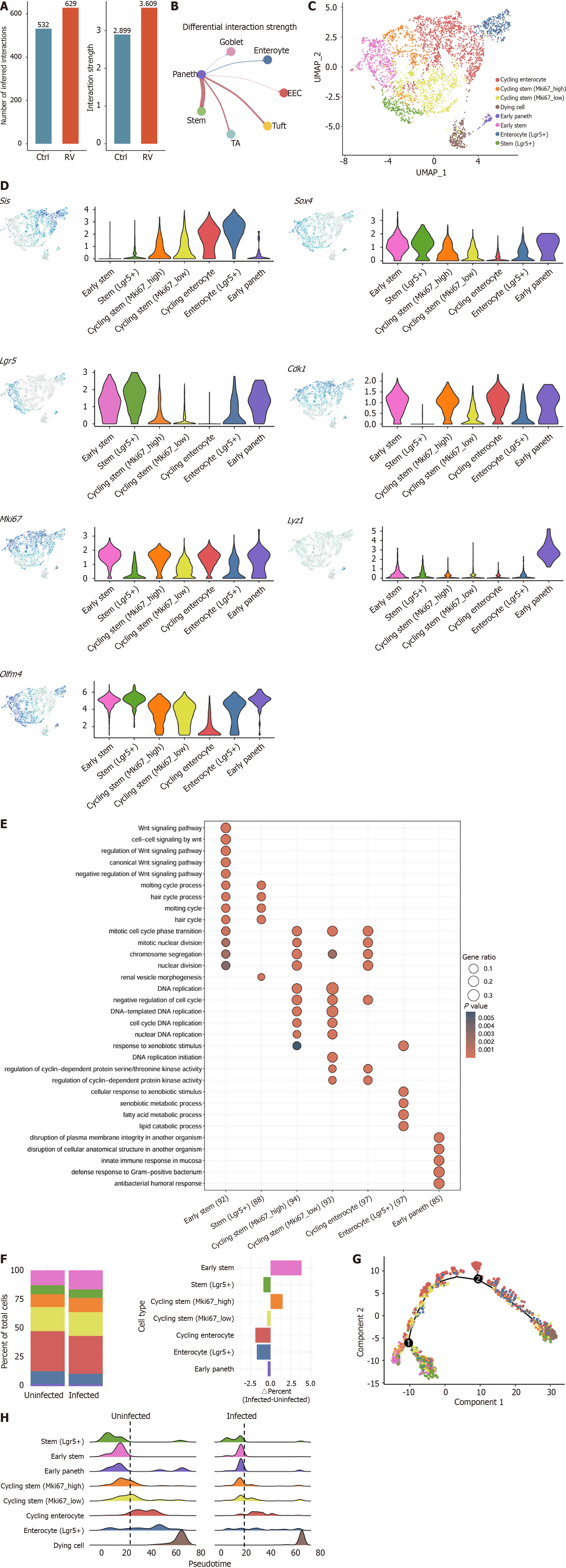Copyright
©The Author(s) 2025.
World J Gastroenterol. Jul 14, 2025; 31(26): 107044
Published online Jul 14, 2025. doi: 10.3748/wjg.v31.i26.107044
Published online Jul 14, 2025. doi: 10.3748/wjg.v31.i26.107044
Figure 3 Rotavirus infection enhances Paneth-intestinal stem cells communication.
A: Quantification of total inferred cell-cell interactions number and strength between intestinal stem cells in uninfected and infected conditions; B: Differential interaction strength analysis of Paneth cells; C: The stem cell cluster in Figure 1B were re-clustered. Uniform manifold approximation and projection of combined subclustered stem cells from uninfected and infected mice; D: Feature plots (left) and violin plots (right) of the expression of representative marker genes of subclustered stem cells; E: Kyoto Encyclopedia of Genes and Genomes pathway enrichment analysis of subclustered stem cells; F: Quantification of percent cells per cluster (left) and difference in percent of uninfected and infected cells (right); G: Pseudotime trajectory analysis of stem cells differentiation; H: Ridge plots comparing the differentiation trajectories of stem cells in uninfected (left) and infected (right) conditions. Ctrl: Control; RV: Rotavirus; EEC: Enteroendocrine cell; TA: Transit-amplifying cell; UMAP: Uniform manifold approximation and projection; Lgr5: Leucine-rich repeat-containing G protein-coupled receptor 5; Mki67: Marker of proliferation Ki-67; Olfm4: Olfactomedin 4; Sox4: SRY-related high-mobility-group box 4; Cdk1: Cyclin-dependent kinase 1; Lyz1: Lysozyme 1.
- Citation: Bu XY, Tan HY, Wang AM, Wei MT, Pan S, Gao JZ, Li YH, Qian GX, Chen ZH, Ye C, Jia WD. Paneth cells inhibit intestinal stem cell proliferation through the bone morphogenic protein 7 pathway under rotavirus-mediated intestinal injury. World J Gastroenterol 2025; 31(26): 107044
- URL: https://www.wjgnet.com/1007-9327/full/v31/i26/107044.htm
- DOI: https://dx.doi.org/10.3748/wjg.v31.i26.107044









